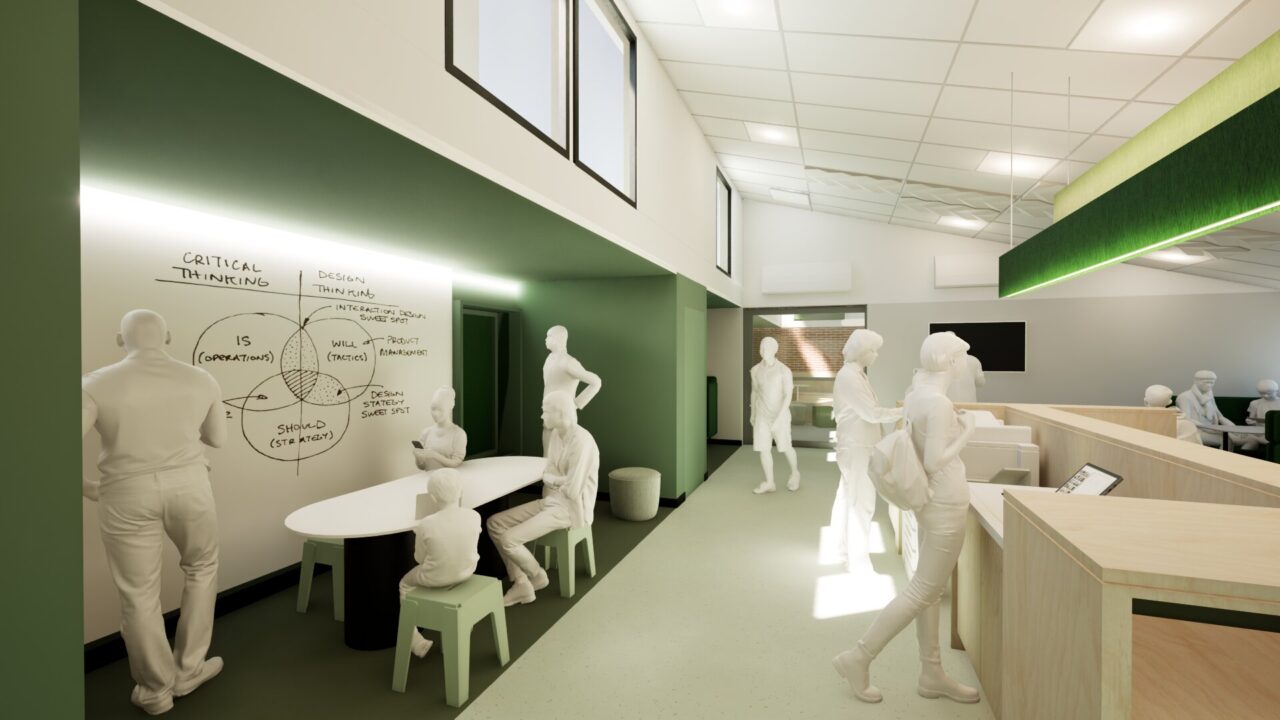
Ms Amelia Apogremiotis | Head of Secondary School
Look at your space with 21st-century eyes. Does it work for what we know about learning today, or just what we knew about learning in the past?
– The Third Teacher: 79 Ways You Can Use Design to Transform Teaching & Learning
A great classroom is one where our students feel inspired to learn. The space itself nurtures their curiosity and drives their ambition. Ideal learning environments aren’t just a dream but a critical factor in shaping student success.
Modern teaching methods demand spaces that allow for more flexibility than is usually possible in traditionally styled classrooms. The new Master Plan Campus Vision is specifically designed to align with the most current research on how boys learn best. It focuses on creating environments that support movement, hands-on learning, and real-life applications, which are key components of boys’ pedagogy. Environments that are thoughtfully designed can foster creativity, collaboration, and critical thinking, playing a crucial role in student engagement and achievement.
Research has shown that students in well-designed spaces perform better academically and exhibit more positive attitudes toward learning. Textures, light, clutter, and colour significantly affect student performance. A lack of light can cause anxiety or stress, whereas employing the principles of colour psychology can drastically improve the effect a classroom has on students’ wellbeing and focus. Boys also benefit from environments that allow for movement and physical activity. Learning spaces with ample natural light, open layouts, calming colours, free-flowing movement, and flexible seating arrangements will feature in the new designs as crucial aspects that cater to boys’ learning styles.
The McKenzie Prototype Classrooms will allow teachers and students to explore different learning spaces to spark curiosity, enabling boys to move around freely and engage in active learning. The space allows design thinking to come alive, with the rooms built to facilitate designing, ideating, prototyping, and testing. Students will be able to brainstorm ideas collaboratively before bringing their designs to life on a 3D printer and testing their solutions in the same space. Boys will have the opportunity to move seamlessly between working collaboratively and independently, solidifying vital skills for their future and building their capacity for complex thinking, which grows in adolescence. This space will afford teachers the opportunity for multidisciplinary learning and cater to boys’ needs for physical engagement and hands-on activities while mirroring the innovative and collaborative work environments they will encounter in their future careers. Data will be collected from our experiences in the Prototype spaces to inform our future classroom developments. The refurbishment of our learning spaces will ensure our classroom environments are up-to-date and fit for purpose. More choices in the types of furniture and styles of learning available to them appeal to boys’ need for autonomy and independence, which grows as they enter their teenage years.
Along with the learning and teaching spaces, areas for students to socialise are vitally important. Social connections increase happiness, health, and longevity, and inviting spaces that allow boys to bond during the day positively impact their mental health and academic performance. At a moment of development when teenagers are looking to the school environment to see where they belong, strong social connections can improve overall wellbeing and enhance cognitive function. Spaces that allow our students to sit and relax or be active with their peers also feature in the Master Plan Campus Vision. Extensive work is underway on the McKenzie and Middle School landscape, with students eagerly awaiting the opportunity to try out the basketball half courts. These facilities are ideal for the development of our younger Secondary Students who use sports as a means of connecting. The communal seating in place around the feature tree in the courtyard is a hive of conversation both before school and during break times as our Years 7 to 9 students gather and bond, which is essential to their developing sense of identity and connection. Friendships formed through these interactions last long after their time at the College has ended, fostering a lifelong support network.
The holistic education offered at the College emphasises balancing academic rigour with physical and mental health. The improvements in the sports training facilities on campus will provide more ways for our young men to strengthen their vital team-building skills. School spirit is a core focus of older Secondary students and something that the current Prefect body has worked hard to develop this year. Planned improvements in spectator facilities will elevate the game-day experience and further enhance opportunities for boys to support their mates on the field. Families, Old Collegians, staff, and the broader community will use these expanded spaces to gather and cheer on our players, strengthening the bonds between the College and its supporters. This will create lasting memories and further fortify the BBC bond of brotherhood among students.
Implementing this Master Plan Campus Vision will significantly enhance the learning experience of our Secondary School students. By prioritising innovative learning spaces, real-life connections, and social wellbeing, our campus will provide boys with more autonomy, purpose-built places for connection, improved wellbeing, and a diverse range of choices in how they learn, setting them up to thrive long after they graduate from the College.